Federal Emergency Management Agency
-
- Confused Seas Maritime Reporter, Aug 2003 #14
Navigating through U.S. Maritime Security Requirements The U.S. Maritime Transportation Security Act (MTSA) imposes various maritime security requirements on operating in waters subject to the jurisdiction of the United States. Maritime security regulations promulgated by the U.S.
Coast Guard implement some (but not all) of the MTSA requirements and impose some additional requirements.
In other words. Congress has imposed various requirements on the owners and operators of ships navigating waters of the United States and the U.S. Coast Guard has not provided full guidance on how to comply with those legislative mandates.
Foreign ships subject to the International Convention for the Safety of Life at Sea (SOLAS Convention) seeking to operate in waters subject to the jurisdiction of the United States will have to undertake their ship security assessments earlier than might be necessary under the ISPS Code. Likewise, they will have to prepare their ship security plan not later than December 29, 2003 (rather than July I. 2004, as provided in the ISPS Code). All commercial ships will have to include in the vessel security plan submitted to the Coast Guard several items that were not listed by the agency in its July 1, 2003 interim rulemaking. As of July 1, 2004. all ships navigating U.S. waters must be operating in compliance with their vessel security plans. There are also differences between the implementation dates of the SOLAS Convention and the U.S. maritime security regulations for carriage of AIS equipment. Specific recommendations for navigating through these confused seas follow. Commence ship security assessment and ship security plan process immediately. Because the U.S. deadline for submittal of vessel security plans is six months sooner than the international deadline, the ship owner/operator must start the process immediately. Even if the process has been initiated, the timeline must be adjusted so that the plan is complete and ready for submittal to the U.S. Coast Guard on or before December 29. 2003.
Prepare a U.S. Appendix to plan The owners and operators of ships subject to SOLAS Convention can comply with these unilateral requirements, in part, by adding a U.S. Appendix to their international ship security plan.
The U.S. Appendix must contain the following elements, which are in addition to the international requirements: • Identification of the Qualified Individual with authority to implement the ship security plan.
• Explanation of how the ship security plan is consistent with the national and area maritime transportation security plans.
• Identification of security measures available under contract or other means approved by the U.S. Coast Guard, necessary to deter to the maximum extent practicable a transportation security incident or substantial threat of such a security incident.
• Provisions for a comprehensive response to a transportation security incident, including notifying and coordinating with local, state, and federal authorities (including the Director of the Federal Emergency Management Agency), securing the ship, and evacuating persons on the ship.
• A copy of the ship security assess- ment.
Recommendations on how to deal with the five elements of the U.S.
Appendix follow: Qualified Individual The maritime security regulations promulgated by the U.S. Coast Guard on July 1, 2003, indicate that the Coast Guard considers the term 'Qualified Individual' to be equivalent to 'ship security officer'. The regulations also provide that vessel security plans should include 24-hour contact information for the company security officer and the ship security officer. It is recommended that the U.S. Appendix to the ISPS Code ship security plan include 24-hour contact information for the company security officer and the ship security officer and also contain a statement indicating that these two officials, along with the master, have authority to implement (he ship security plan, including the U.S.
Appendix.
Consistency with National and Area Plans The national and area maritime transportation security plans are currently under development. It is recommended that, until those plans are promulgated, the U.S. Appendix to the ISPS Code security plan include a provision to the following effect: A subsequent iteration of this ship security plan will be made consistent with the U.S. national and area maritime transportation security plans after those plans have been promulgated. In the meantime, this ship will be operated consistent with applicable maritime transportation security requirements promulgated by the U.S. Coast Guard at the national or area (e.g., Captain of the Port) level.
Identification of Security Measures The U.S. Coast Guard has not identified any specific security measures (other than those to be implemented by the company and the ship, under the ISPS Code), which should be included in the U.S. version of the ship security plan.
Rather, the Coast Guard has broad authority under the MTSA and elsewhere to mandate additional specific security measures to meet identified threats. It is therefore recommended that the U.S.
Appendix to the ISPS Code ship security plan include a provision to the following effect: The master, the vessel security officer, and the company security officer each have authority to implement additional security measures that may be directed by the U.S. Coast Guard. As necessary, these additional security measures may be implemented by means of contract or other means approved by the U.S. Coast Guard.
Transportation Security Incident Response Maritime transportation security plans in the United States are to include provision for a comprehensive response to an emergency, including notifying and coordinating with local, state, and federal authorities (including the Director of the Federal Emergency Management Agency - FEMA - now called the Under Secretary of Homeland Security for Emergency Preparedness and Response), securing the vessel or facility, and evacuating vessel or facility personnel. It is recommended that the U.S. Appendix to the ISPS Code ship security plan include the following: • A notification section (resembling the notification section found in vessel response plans - VRPs or shipboard oil pollution emergency plans - SOPEPs), but including names and telephone numbers of local, state, and federal government emergency response agencies and specifically including the Under Secretary of Homeland Security for Emergency Preparedness and Response. It should be noted that the main telephone number for the Under Secretary of Homeland Security for Emergency Preparedness and Response is (202) 566-1600. It is suggested that this telephone number be included in the notification section.
• A provision for securing the ship, addressing issues such as securing power and water; terminating cargo-handling operations; bunkering, and loading of stores; and doubling up of lines and other means of enhancing the ability of the ship to remain at its current location.
• A provision for evacuating all persons on the ship, including means for assembling in a safe location and accounting for all persons.
Ship Security Assessment The ISPS Code requires owners and operators of ships subject to the SOLAS Convention to conduct a ship security assessment, in accordance with published guidelines, prior to development of the ship security plan. The ISPS Code appears to treat the ship security assessment as an internal company document, as the Code is silent regarding any use of the assessment other than preparation of the ship security plan. On the other hand, the maritime security regulations promulgated by the U.S. Coast Guard mandate that owners and operators of ships requiring U.S.-approved vessel security plans include a copy of the vessel security assessment with the vessel security plan when it is submitted for USCG review.
AIS The SOLAS Convention, as amended, has a timeline for carriage of automatic identification system (AIS) equipment, depending on the type vessel and its size.
The MTSA has a similar, but not identical, timeline. The maritime security regulations generally follow the SOLAS approach, but have special compliance dates for vessels transiting various vessel traffic service (VTS) areas. As most vessels engaged in international trade must be capable of entering all major ports, it is recommended that AIS be installed not later than July 1, 2004. unless an earlier installation date is mandated by SOLAS.
It is highly unfortunate that the U.S. Congress adopted a unilateral approach to addressing the multilateral problem of maritime security. The U.S. Coast Guard attempted to convince Congress that vigorous port state control efforts of international requirements would provide the nation (and the world) with a high level of security. Those efforts, though, fell on deaf ears, with Congress insisting on full compliance with the provisions of the MTSA. The owners and operators of ships operating in U.S. waters are stuck in the middle - with two masters issuing similar, but not identical, orders. The above recommendations are intended to address the gaps between the MTSA and the maritime security regulations promulgated by the U.S. Coast Guard.
-
- Key Port Security Measure Passed Maritime Reporter, Apr 2002 #16
," said Kurt J. Nagle, president of the American Association of Port Authorities (AAPA). "We are encouraged about the $225 million authorized for Federal grants to help ports enhance seaport security, and the local flexibility provided for vessels and facilities to address terrorism at America's
-
- Manage and Mitigate Risk on the Water Marine News, Apr 2016 #26
against flooding. Workboat owners need to buy a separate flood policy through the National Flood Insurance Program, administered by the Federal Emergency Management Agency, or risk facing thousands of dollars in flood damages in the winter months. Finally, it is essential workboat owners seek out an
-
- Op/Ed: What Good Boats Can Do Marine News, Dec 2019 #22
assessment. OMSA was able to provide a database of over 50 immediately available assets to response organizations including the USCG and the Federal Emergency Management Agency (FEMA). This database demonstrated the multiple capabilities of marine assets that were instantly available for response operations
-
- As Interest in LNG Surges, Regulators Struggle to Keep Pace Maritime Reporter, Dec 2014 #20
(DOT) Transportation Investment Generating Economic Recovery (TIGER) infrastructure grant program; port security grants at the Federal Emergency Management Agency (FEMA), a part of the Department of Homeland Security (DHS); Small Shipyard Grants at MARAD/DOT; the Capital Construction Fund (CCF)
-
- Secure Marine Transportation... Priceless? Maritime Reporter, Feb 2003 #12
(QI) having full authority to implement security actions, and require immediate communications between that individual and the appropriate Federal official (presumably the COTP) and the persons providing additional security. It is unclear what qualifications will be expected of a QI. If it
-
- Meet SFFD’s New Fireboat Technology Maritime Reporter, Nov 2015 #126
Grant was lost because the San Francisco Fire Department did not spend the money in the given time frame. The grant was awarded by the Federal Emergency Management Agency (FEMA) in 2009 to San Francisco for Port Security, namely the funding of a new fireboat in which the City would have to match the grant
-
 )
March 2024 - Marine Technology Reporter page: 45
)
March 2024 - Marine Technology Reporter page: 45ronments. The new agreement will address speci? c techni- cal gaps in the UUV defense and offshore energy markets especially for long duration, multi-payload mission opera- tions where communications are often denied or restricted. As part of the new alliance, Metron’s Resilient Mission Autonomy portfolio
-
 )
March 2024 - Marine Technology Reporter page: 36
)
March 2024 - Marine Technology Reporter page: 36LANDER LAB #10 Of special interest for marine applications, LiPo batteries are Shipping any kind of lithium battery can be a challenge, and offered in a “pouch” design, with a soft, ? at body. The pouch IATA regs vary with the batteries inside or outside an instru- is vacuum-sealed, with all voids ?
-
 )
March 2024 - Marine Technology Reporter page: 19
)
March 2024 - Marine Technology Reporter page: 19About the Author vey with the pipe tracker is not required, resulting in signi? - Svenn Magen Wigen is a Cathodic Protection and corrosion control cant cost savings, mainly related to vessel charter. expert having worked across The major advantage of using FiGS on any type of subsea engineering, design
-
 )
March 2024 - Marine Technology Reporter page: 15
)
March 2024 - Marine Technology Reporter page: 15sensor options for longer mission periods. About the Author For glider users working in ? sheries and conservation, Shea Quinn is the Product Line Manager the Sentinel can run several high-energy passive and active of the Slocum Glider at Teledyne Webb acoustic sensors, on-board processing, and imaging
-
 )
March 2024 - Marine Technology Reporter page: 6
)
March 2024 - Marine Technology Reporter page: 6MTR Editorial Advisors Gallaudet Hardy The Honorable Tim Gallaudet, Kevin Hardy is President PhD, Rear Admiral, U.S. of Global Ocean Design, Navy (ret) is the CEO of creating components and Ocean STL Consulting and subsystems for unmanned host of The American Blue vehicles, following a career
-
 )
April 2024 - Maritime Reporter and Engineering News page: 39
)
April 2024 - Maritime Reporter and Engineering News page: 39Tech Files Latest Products, Systems and Ship Designs “Wall Climbing Robot” Danish Pilot calls gets ClassNK Nod LEGO Model "A tribute build to a work life at sea" Image courtesy MOL, Sumitomo Heavy Industries lassNK granted its Innovation Endorse- Image courtesy Espen Andersen/DanPilot ment for
-
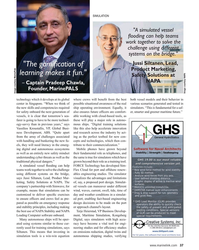 )
April 2024 - Maritime Reporter and Engineering News page: 37
)
April 2024 - Maritime Reporter and Engineering News page: 37SIMULATION "A simulated vessel ? ooding can help teams work together to solve the challenge using different systems on the bridge." – Jussi Siltanen, Lead, "The gami? cation of Product Marketing, learning makes it fun." Safety Solutions at NAPA – Captain Pradeep Chawla, Founder, MarinePALS Image
-
 )
April 2024 - Maritime Reporter and Engineering News page: 35
)
April 2024 - Maritime Reporter and Engineering News page: 35SIMULATION e have a close relationship with tech- Realism is prized beyond immersive, photo-realistic visu- nology, evidenced by, for example, als, and providers are introducing increasingly accurate func- the phones we are estimated to un- tionality. FORCE Technology’s upcoming DEN-Mark2 math- lock around
-
 )
April 2024 - Maritime Reporter and Engineering News page: 28
)
April 2024 - Maritime Reporter and Engineering News page: 28FEATURE INTERVIEW track missiles and warheads for the Mis- sile Defense Agency, and it travels with its support ship, the MV Hercules. For our Service Support ships, we have the two hospital ships, USNS Mer- cy and Comfort; two rescue and salvage ships; two submarine tenders; and the Sixth Fleet ?
-
 )
April 2024 - Maritime Reporter and Engineering News page: 27
)
April 2024 - Maritime Reporter and Engineering News page: 27RADM PHILIP SOBECK, MILITARY SEALIFT COMMAND With COVID, we had to make some hard choices for our Do your CIVMARs have upward mobility? mariners because we couldn’t rotate. Many of our mariners The Navy has Sailors who become “Mustangs,” and work found other employment, and were able to use their skills
-
 )
April 2024 - Maritime Reporter and Engineering News page: 26
)
April 2024 - Maritime Reporter and Engineering News page: 26FEATURE INTERVIEW “Over the next decade, 12 new classes of ships will come online and MSC will see up to 20 new ships deliver to the ? eet in the next ? ve years. This includes new oilers, towing, salvage and rescue tugs, and expeditionary fast transports and emergency medical ships. A large
-
 )
April 2024 - Maritime Reporter and Engineering News page: 25
)
April 2024 - Maritime Reporter and Engineering News page: 25RADM PHILIP SOBECK, MILITARY SEALIFT COMMAND Photo by Brian Suriani USN Military Sealift Command From a global supply chain perspective, What makes MSC so vital to the we’ve learned a lot about dealing with Navy’s ? eet and our military disruptions. COVID delivered a big forces around the world? wake-up
-
 )
April 2024 - Maritime Reporter and Engineering News page: 14
)
April 2024 - Maritime Reporter and Engineering News page: 14Book Review Approach to Meeting Underwater Radiated Noise Limits Def ned By Raymond Fischer uantitative underwater radiated noise limits will construction inspections, 5) possible training with respect to be developed shortly by IMO, and/or countries salient design/construction essentials, 6) compliance
-
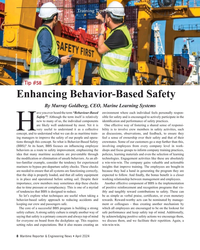 )
April 2024 - Maritime Reporter and Engineering News page: 8
)
April 2024 - Maritime Reporter and Engineering News page: 8Training Tips for Ships © By tuastockphoto/AdobeStock Tip #58 Enhancing Behavior-Based Safety By Murray Goldberg, CEO, Marine Learning Systems ave you ever heard the term “Behaviour-Based environment where each individual feels personally respon- Safety”? Although the term itself is relatively sible for
-
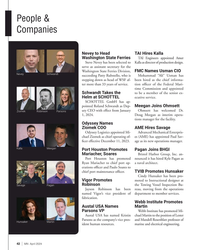 )
April 2024 - Marine News page: 42
)
April 2024 - Marine News page: 42is Mohammad “Ali” Usman has stepping down as head of WSF af- been hired as the chief informa- ter more than 33 years of service. tion of? cer of the Federal Mari- time Commission and appointed Schwandt Takes the to be a member of the senior ex- Helm at SCHOTTEL ecutive service. SCHOTTEL GmbH has ap- pointed
-
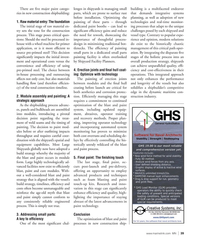 )
April 2024 - Marine News page: 39
)
April 2024 - Marine News page: 39There are ? ve major paint catego- lenges in shipyards is managing small building is a multifaceted endeavor ries in new construction shipbuilding: parts, which are prone to surface rust that demands integrative systems before installation. Optimizing the planning, as well as adoption of new 1.
-
 )
April 2024 - Marine News page: 34
)
April 2024 - Marine News page: 34Feature Electric Tugs All images courtesy Eric Haun The eWolf’s power integrates into eWolf features a 6.2 MWh Orca ABB’s DC grid architecture, which battery energy storage system distributes to all the consumers from Corvus Energy. throughout the vessel. 12 to 16 inches. If you’ve got 14 inches and
-
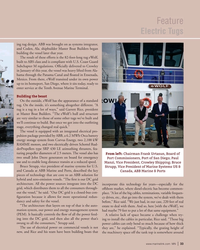 )
April 2024 - Marine News page: 33
)
April 2024 - Marine News page: 33Feature Electric Tugs ing tug design. ABB was brought on as systems integrator, and Coden, Ala. shipbuilder Master Boat Builders began building the vessel later that year. The result of these efforts is the 82-foot-long tug eWolf, built to ABS class and is compliant with U.S. Coast Guard Subchapter M
-
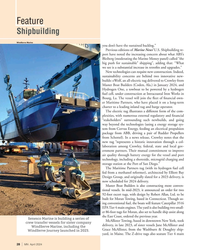 )
April 2024 - Marine News page: 28
)
April 2024 - Marine News page: 28Propellers from Schottel). In a news release, Crowley notes that the new tug “represents a historic innovation through a col- laboration among Crowley, federal, state and local gov- ernment partners. Their mutual commitment to improve air quality through battery energy for the vessel and port technology
-
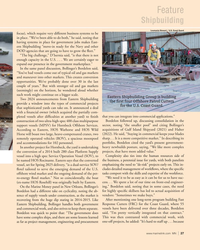 )
April 2024 - Marine News page: 27
)
April 2024 - Marine News page: 27Feature Shipbuilding Loumania Stewart / U.S. Coast Guard focus), which require very different business systems to be in place. “We’ve been able to do both,” he said, noting that having systems in place for government jobs makes East- ern Shipbuilding “move-in ready for the Navy and other DOD agencies
-
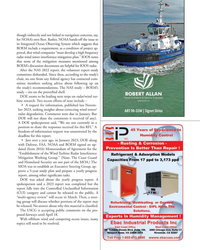 )
April 2024 - Marine News page: 25
)
April 2024 - Marine News page: 25for IOOS radar. After the NAS 2022 report, the volunteer expert study committee disbanded. Since then, according to the study’s chair, no one from any federal agency has contacted com- mittee members seeking advice about following up on the study’s recommendations. The NAS study – BOEM’s study – sits on
-
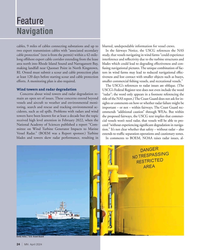 )
April 2024 - Marine News page: 24
)
April 2024 - Marine News page: 24commercial ? shing vessels, and recreational vessels.” The USCG’s references to radar issues are oblique. (The Wind towers and radar degradation USCG’s Federal Register text does not even include the word Concerns about wind towers and radar degradation re- “radar”; the word only appears in a footnote referencing
-
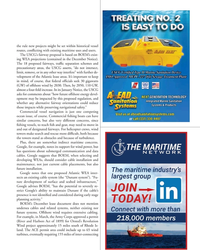 )
April 2024 - Marine News page: 23
)
April 2024 - Marine News page: 23, limit, remove, or in any other way interfere” with further de- velopment of the Atlantic lease areas. It’s important to keep in mind, of course, that federal of? cials seek 30 gigawatts (GW) of offshore wind by 2030. Then, by 2050, 110 GW, almost a four-fold increase. In its January Notice, the USCG
-
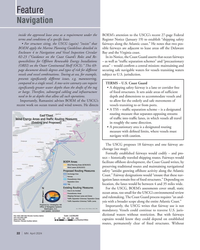 )
April 2024 - Marine News page: 22
)
April 2024 - Marine News page: 22Feature Navigation inside the approved lease area as a requirement under the BOEM’s attention to the USCG’s recent 27-page Federal terms and conditions of a speci? c lease. Register Notice (January 19) to establish “shipping safety • For structure siting, the USCG (again) “insists” that fairways along
